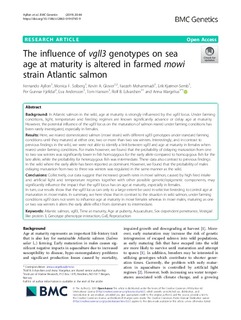| dc.description.abstract | Background:
In Atlantic salmon in the wild, age at maturity is strongly influenced by the vgll3 locus. Under farming conditions, light, temperature and feeding regimes are known significantly advance or delay age at maturity. However, the potential influence of the vgll3 locus on the maturation of salmon reared under farming conditions has been rarely investigated, especially in females.
Results:
Here, we reared domesticated salmon (mowi strain) with different vgll3 genotypes under standard farming conditions until they matured at either one, two or more than two sea winters. Interestingly, and in contrast to previous findings in the wild, we were not able to identify a link between vgll3 and age at maturity in females when reared under farming conditions. For males however, we found that the probability of delaying maturation from one to two sea winters was significantly lower in fish homozygous for the early allele compared to homozygous fish for the late allele, while the probability for heterozygous fish was intermediate. These data also contrast to previous findings in the wild where the early allele has been reported as dominant. However, we found that the probability of males delaying maturation from two to three sea winters was regulated in the same manner as the wild.
Conclusions:
Collectively, our data suggest that increased growth rates in mowi salmon, caused by high feed intake and artificial light and temperature regimes together with other possible genetic/epigenetic components, may significantly influence the impact that the vgll3 locus has on age at maturity, especially in females. In turn, our results show that the vgll3 locus can only to a large extent be used in selective breeding to control age at maturation in mowi males. In summary, we here show that in contrast to the situation in wild salmon, under farming conditions vgll3 does not seem to influence age at maturity in mowi females whereas in mowi males, maturing as one or two sea winters it alters the early allele effect from dominant to intermediate | nb_NO |
